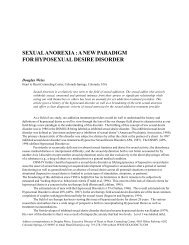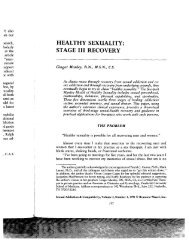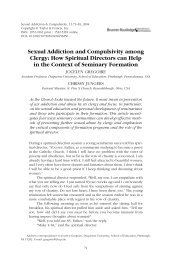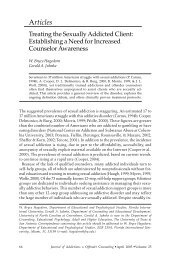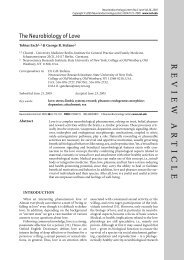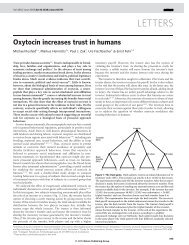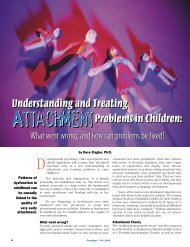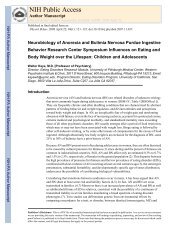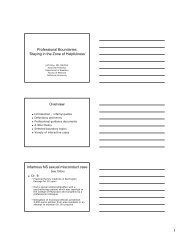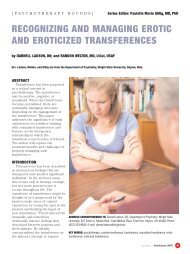Coverage and Liability Issues in Sexual Misconduct Claims
Coverage and Liability Issues in Sexual Misconduct Claims
Coverage and Liability Issues in Sexual Misconduct Claims
- No tags were found...
Create successful ePaper yourself
Turn your PDF publications into a flip-book with our unique Google optimized e-Paper software.
MINNESOTAStatute of LimitationsThe period of limitations is 2 years for personal <strong>in</strong>juries result<strong>in</strong>g fromassault, battery, false imprisonment, or other tort. M<strong>in</strong>n. Stat. § 541.07.Actions for damages caused by sexual abuse must be commencedwith<strong>in</strong> 6 years of the time the claimant knew or had reason to knowthat the <strong>in</strong>jury was caused by the sexual abuse. Id. at § 541.073. Thissection applies to an action for damages commenced aga<strong>in</strong>st a personwho caused the personal <strong>in</strong>jury either by (1) committ<strong>in</strong>g the sexualabuse, or (2) negligently permitt<strong>in</strong>g the sexual abuse to occur. Id. at§ 541.073(d). This rule, known as the delayed discovery rule, exists toprotect <strong>in</strong>dividuals who are psychologically, physically or emotionallyunable to recognize that they have been abused with<strong>in</strong> the timeconstra<strong>in</strong>ts of § 541.07. See W.J.L. v. Bugge, 573 N.W.2d 677 (M<strong>in</strong>n.1998); Blackowiak v. Kemp, 546 N.W.2d 1 (M<strong>in</strong>n. 1996).Delayeddiscovery rule applies to claims assert<strong>in</strong>g respondeat superior liability.D.M.S. v. Barber, 645 N.W.2d 383 (M<strong>in</strong>n. 2002).Note: Legislation seek<strong>in</strong>g to extend the statute of limitations for sexualabuse to m<strong>in</strong>ors was narrowly defeated by the M<strong>in</strong>nesota legislature <strong>in</strong>2004.Report<strong>in</strong>g LawsOtherM<strong>in</strong>n. Stat. Ann. § 626.556 et. seq.In Fahrendorff ex rel. Fahrendorff v. North Homes, Inc., 597 N.W.2d905 (M<strong>in</strong>n. 1999), the M<strong>in</strong>nesota Supreme Court found it was aquestion of fact whether an employer could be strictly liable for sexualabuse <strong>in</strong> a group home <strong>in</strong>dustry because an employer engaged <strong>in</strong>that bus<strong>in</strong>ess should bear the loss associated with such abuse as aforeseeable cost of do<strong>in</strong>g bus<strong>in</strong>ess.The M<strong>in</strong>nesota courts heard cases aga<strong>in</strong>st religious organizations.See Black v. Snyder, 471 N.W.2d 715 (M<strong>in</strong>n. Ct. App. 1991) (Permitt<strong>in</strong>glitigation of sexual harassment claim aga<strong>in</strong>st church). An award ofpunitive damages aga<strong>in</strong>st church for negligence <strong>in</strong> permitt<strong>in</strong>g sexualabuse of child did not violate the Free Exercise Clause. Mrozka v.Archdiocese of St. Paul & M<strong>in</strong>neapolis, 482 N.W.2d 806 (M<strong>in</strong>n. Ct.App. 1992).<strong>Claims</strong> for clergy malpractice <strong>and</strong> negligent counsel<strong>in</strong>gwere dismissed <strong>in</strong> an action aga<strong>in</strong>st a m<strong>in</strong>ister <strong>and</strong> church conference.Odenthal v. M<strong>in</strong>nesota Conference of Seventh-Day Adventists, 657N.W.2d 569 (M<strong>in</strong>n. App. 2003). The First Amendment did not requiredismissal of negligence claims aga<strong>in</strong>st church for sexual misconduct ofpastor where neutral pr<strong>in</strong>ciples of law could be applied without regardto particular religious doctr<strong>in</strong>e. Olson v. First Church of Nazarene,661 N.W.2d 254 (M<strong>in</strong>n. App. 2003). See also, J. M. v. M<strong>in</strong>nesota Dist.Council, 658 N.W.2d 589 (M<strong>in</strong>n. App. 2003).– 35 –



